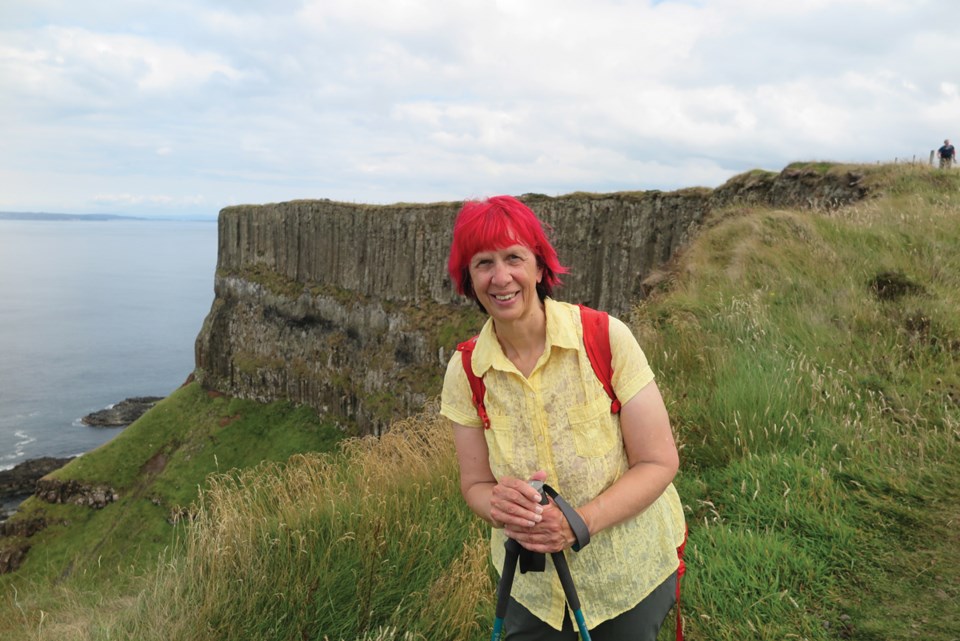Encouraged by the archeologist guide, I moved further into the underground passage in Loughcrew Cairn T, the Hag’s Cairn, in County Meath, Ireland, and clambered over the low stone slab to the small burial chamber. There I could be alone to discover my own instance of eternity. Crouched in a tomb older than the Pyramids, I just knew this hiking trip to the north of Ireland would take me to the strangest places.
Loughcrew Cairn was the first stop in the week’s guided hiking tour. There were six in our group, my partner and I, another Canadian, a woman from Bristol, and a couple from Connecticut. We spent our first two nights in the Irish Lake District of Fermanagh. On our first day’s hike, we followed a farmyard track and then steadily climbed the boardwalk of the Cuilcagh Legnabrocky Trail to the summit with its astounding view of the lakes below. The boardwalk protects the surrounding blanket bog, a two-to- three-metre deep layer of peat that is being restored to its natural wetness. The bog is one of the most intact of Western Europe and is important for holding carbon and thus preventing further global warming. As I stooped over to pick a wild blueberry, I also appreciated the bird’s eye view that a hiking trip offers.
The next morning we boarded battery-driven skiffs to explore a subterranean river in the Marble Arch Caves. A UNESCO geopark, the caves with their stalactites, stalagmites, columns, curtains, and flowstones brought back to me my love of limestone karst formations, such as found in the Canadian Rockies and on Vancouver Island. In contrast, the afternoon found us on the Londonderry city walls, built in 1613-1618 to protect the English and Scots settlers of the new town that formed part of the Plantation of Ulster, an early colonization by King James 1 of England. From the stone walls, we looked downwards to the Derry Bogside murals memorializing the Irish civil rights movement and Bloody Sunday, when British paratroopers killed 13 civilians in 1971, and we were reminded of the time of The Troubles. I found it hopeful that a mural from 1999 had been repainted in 2006, with its once intact rifle now depicted as broken in two.
After a morning spent at the museum dedicated to the Irish Nobel Prize winning poet Seamus Heaney, we headed for the Giant’s Causeway, made famous by HBO’s Game of Thrones. Although the 40,000 interlocking basalt columns, some more than 25 metres high, were impressive and it is fun to climb up on them if you dare, the almost 12-kilometre walk along the Atlantic coast to reach the Causeway was even more miraculous for its wide ocean views, stunning rock formations, and relative solitude. The next morning we ventured across the Carrick-a-Rede rope bridge built by fishers 350 years ago to reach Carrickarede Island and the best salmon spots. The views we enjoyed there of Rathlin Island and Scotland were as exciting as the traversing of the 20-metre long, 30-metre high bridge.
Then it was back to the city, to Belfast. We first climbed Cave Hill, reached from the grounds of Belfast Castle, to gain an overview of the city and harbour, where we could see ferries sailing to Liverpool and the Isle of Man. We booked a black cab tour of the Belfast murals and peace walls, the separation barriers that divided predominantly Republican and Nationalist Catholic neighbourhoods from predominantly Loyalist and Unionist Protestant ones. Most impressive in the Protestant Shankill area was the house-high Women’s Quilt mural born out of women’s insistence to be heard. The Ulster Museum was a marvelous find with its many exhibits and all free of charge.
Visiting the Saint Patrick Centre at Downpatrick was worthwhile, if only to hear Irish film actor Ciaran Hinds giving voice to the saint. Murlough Beach allowed me to dip my toes in the Irish Sea, but my favourite hike of the week was the last day when we hiked the Smuggler’s Trail through the centre of the Mourne Mountains. We followed the rock path, which was once used to bring in brandy from the Isle of Man and smuggle out bodies for the medical schools of Scotland, ever upward to lunch among the gorse and heather overlooking Silent Valley. As fog gave way to clear skies, we scrambled over our highest point and then worked our way downward. Ireland had won my heart, especially during this last hike where, according to the Percy French ballad, “the Mountains of Mourne sweep down to the sea.”
My flights were booked through a Sunshine Coast travel agency, and the guided hiking was with Footfalls Walking Holidays, an Irish family company. The tour of Londonderry was with Martin McCrossan City Walking Tours and of Belfast was with Paddy Campbell’s Black Cab Tours.
See Part 2 of this article in next week’s Coast Reporter, Sept. 21.



